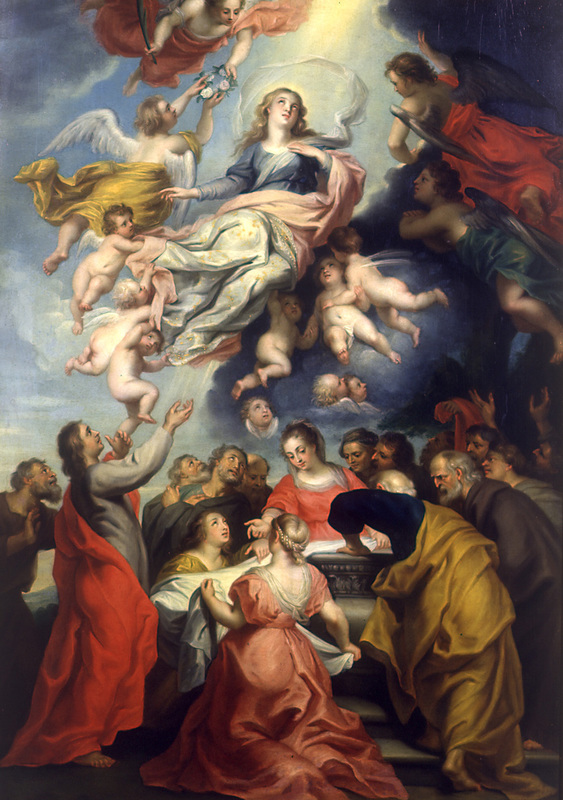 by Theresa Cavicchio
by Theresa Cavicchio“The Most Blessed Virgin Mary, when the course of her earthly life was completed, was taken up body and soul into the glory of heaven, where she already shares in the glory of her Son’s Resurrection, anticipating the resurrection of all members of his Body” (Catechism of the Catholic Church, 974).
Belief among the faithful that the Blessed Virgin Mary had been assumed bodily into heaven had been centuries old already in the time of Saint Anthony of Padua (1195 – 1231 A.D.). However, it wasn’t until 1950 that Pope Pius XII clearly defined and promulgated as dogma Our Lady’s Assumption “body and soul into heavenly glory,” as follows.
“By the authority of our Lord Jesus Christ, of the Blessed Apostles Peter and Paul, and by our own authority, we pronounce, declare, and define it to be a divinely revealed dogma: that the Immaculate Mother of God, the ever Virgin Mary, having completed the course of her earthly life, was assumed body and soul into heavenly glory” (Munificentissimus Deus, 44).
In this official Vatican document, the Holy Father cited testimony from an imposing list of illustrious figures in the Church – saintly scholars, theologians, and prelates. He devoted an entire paragraph to Anthony of Padua, “the Evangelical Doctor,” a title bestowed on Anthony for his prodigious knowledge of Sacred Scripture (29).
One of the most beloved of all saints, Anthony had earned renown also for his powerful preaching and miraculous intercessions during his lifetime. Gentle and unassuming as a Franciscan friar, though of noble birth and brilliant intellect, he exemplified a passion for following the Gospel of Jesus in poverty and humility in the footsteps of Francis of Assisi.
Also like Francis, another of Anthony’s admirable qualities was his deep, abiding love for Our Blessed Mother. Remarkable for the medieval times in which he lived is the fact that we still have access to numerous sermons composed by him. Many contain references to Our Lady, while others focus entirely on various events in her life as revealed in Sacred Scripture.
As noted above, Anthony joined other Church dignitaries in promoting belief in Mary’s Assumption many years – even centuries – before the dogma was proclaimed officially. Taking a reference from Anthony’s sermon on this very topic, Pope Pius stated: “And he [Saint Anthony] asserts that, just as Jesus Christ has risen from the death over which he triumphed and has ascended to the right hand of the Father, so likewise the ark of his sanctification ‘has risen up, since on this day the Virgin Mother has been taken up to her heavenly dwelling.’"
Saint Anthony’s belief in the reality of the Assumption is firmly rooted in Sacred Scripture. An in-depth 1952 article by noted Franciscan scholar and author Rev. Raphael Huber, OFM Conv., provides several examples; one follows.
“Explaining the text in Psalm 131: 8, … ‘Arise, O Lord into Thy resting place: Thou and the Ark, which Thou hast sanctified,’ St. Anthony says that the first part of this verse refers to Christ's Resurrection and Ascension, the second part to the ‘ark which Thou hast sanctified,’ i.e. to Christ's Blessed Mother, whom [on this day] He took up to Himself into Heaven.”
“Continuing with the thought of the ‘ark which the Lord had sanctified,’ … St. Anthony compares Mary with the ark of Noah which after the flood finally rested on Mt. Ararat in the mountains of Armenia, … because in Her Assumption She ‘was placed above the choirs of Angels.’"
Father Huber continues his explanation of Saint Anthony’s position: “Because it was from Mary's chaste body that the Son of God assumed flesh and blood, it behooved God to preserve Her body as free from material, corporeal corruption as He did the body of His Son through the latter's Resurrection and Ascension.”
In the effable plan of God, it may well be that the strong, loving connection between Saint Anthony of Padua and the Blessed Virgin Mary initiated on the very day of his birth – August 15, 1195. As the saying goes, with God, there are no coincidences.
It has been said that even as a very young child, Anthony spoke with Our Lady in simple words of affection flowing from his innocent heart. All through his life, this connection of genuine devotion continued to grow. Throughout his ministry, in his preaching and in his writing, Anthony voiced the praises of the one chosen by God to be the Mother of His Son, and died with her name on his lips in the words of a hymn: O Glorious Lady!
As we honor Our Lady on her feast day, it is fitting to conclude with a reflection cited as a poem written by Saint Anthony of Padua marking her Assumption into heaven. May Saint Anthony be an example to us of steadfast, genuine love for her throughout our lives.
The Praises of Mary O how wondrous is the dignity of the glorious Virgin! She merited to become the mother of Him who is the strength and beauty of the angels and the grandeur of all the saints.
Mary was the seat of our sanctification, that is to say, the dwelling place of the Son who sacrificed Himself for us.
"And I shall glorify the place where my feet have stood." The feet of the Savior signify his human nature. The place where the feet of the Savior stood was the Blessed Mary, who gave him his human nature.
Today the Lord glorifies that place, since He has exalted Mary above the choirs of the angels.
That is to say, the Blessed Virgin, who was the dwelling of the Savior, has been assumed bodily into heaven.
© All Rights Reserved, Living His Life Abundantly®/Women of Grace® http://www.womenofgrace.com
